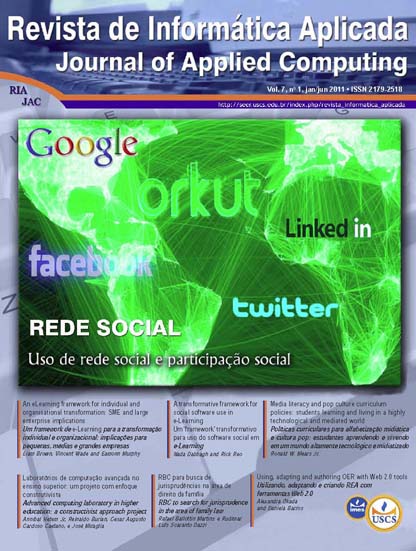Using, Adapting and Authoring OER with Web 2.0 Tools Utilizando, Adaptando e Criando REA com Ferramentas Web 2.0
DOI:
https://doi.org/10.13037/ria.vol7n1.1655Abstract
O objetivo deste trabalho se concentra na criação, utilização e reutilização de Recursos EducacionaisAbertos (REA), através de ferramentas Web 2.0. O objetivo desta pesquisa é para destacar
exemplos inovadores das melhores práticas e também enfatizar as questões-chave para a aplicação de
tecnologias da Web 2.0 baseada em utilização, adaptação e criação de conteúdo para o ensino e aprendizagem
no Ensino Superior.
Downloads
References
ALEXANDER, B. Social networking in Higher Education in The Tower and The Cloud: Higher Education in the age of Cloud Computing, Educause, Boulder, Colorado, 2008.
CARSTEN, U., KERSTIN, B., HENG L., XIAOHONG, T., LIPING, S., & RUIMIN, S. Why web 2.0 is good for learning and for research: principles and prototypes. Paper presented at the Proceeding of the 17th international conference on World Wide Web, 2008.
CRAM, A., KUSWARA, A. & RICHARDS, D. Web 2.0 supported collaborative learning activities: Towards an affordance perspective In L. Cameron & J. Dalziel (Eds), Proceedings of the 3rd International LAMS & Learning Design Conference 2008: Perspectives on Learning Design. (p.p. 70-80). Sydney: LAMS Foundation, 2008. http://lams2008sydney.lamsfoundation.org/papers.htm The Committee of Inquiry into the Changing Learner Experience, Higher Education in a Web 2.0 World Report of an independent, 2010. www.clex.org.uk.
DUFFY, PETER D. AND BRUNS, AXEL. The Use of Blogs, Wikis and RSS in Education: A Conversation of Possibilities. In: Online Learning and Teaching Conference 2006, 26 Sep. 2006, Brisbane, 2006.
FRANKLIN ASSOCIATES. Current and developing international practice in the use of Web 2.0.[online], 2008. Clex. Available at: www.clex.org.uk.
MASON, R. and RENNIE, F. Using Web 2.0 for learning in the community. The Internet and Higher Education, 10 (3) 196—203, 2007.
MASON, R. and RENNIE, F. e-Learning and Social Networking Handbook. Routledge: London, 2008.
MINOCHA, S. A study of the effective use of social software to support student learning and engagement, JISC, University of Bristol, 2009. http://www.jisc.ac.uk/whatwedo/projects/socialsoftware08.aspx.
O'REILLY, TIM, What is Web 2.0: Design Patterns and Business Models for the Next Generation of Software. Communications & Strategies, No. 1, p. 17, First Quarter (2007), 2009. Available at SSRN: http://ssrn.com/abstract=1008839.
RECKER, M., DORWARD, J., NELSON, L.M. Discovery and Use of Online Learning Resources: Case Study Findings. Educational Technology & Society 7(2), 93-104, 2004.
STEVENS, V. Revisiting Multiliteracies in Collaborative Learning Environments: Impact on Teacher Professional Development. TESL-EJ, 7, 4, 2006.
THORPE, M. GREANEY, P. and PETTIT, J. A guide to using Delicious, Google Reader and Twitter in the context of an Open University course: H800 Technology-enhanced Learning: practices and debates 2009. Available at: http://www.open.ac.uk/cetl-workspace/cetlcontent/documents/4a27ee9decbae.pdf
Downloads
Published
Issue
Section
License
Copyright (c) 2012 Alexandra Okada, Daniela Barros

This work is licensed under a Creative Commons Attribution-NonCommercial-ShareAlike 4.0 International License.
Os autores que publicam trabalhos na RIA estão de acordo com os seguintes termos:
- Autores mantêm seus direitos autorais e concedem à RIA o direito à primeira publicação. Admite-se o compartilhamento do referido trabalho, desde que seja reconhecida sua autoria e publicação inicial nesta revista.
- Autores podem fechar contratos adicionais separadamente, para distribuição não exclusiva da versão do trabalho publicado na RIA, com reconhecimento de sua autoria e publicação inicial nesta revista.
- Autores podem publicar e distribuir seu trabalho online, antes ou durante o processo editorial.


